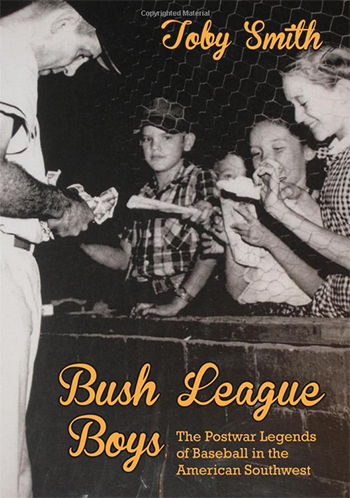
This week we ask one of New Mexico’s great storytellers and reporters, Toby Smith, about his new book Bush League Boys: The Postwar Legends of Baseball in the American Southwest, published this year by University of New Mexico Press.
New Mexico Mercury: Anyone who loves baseball and is interested in understanding more about the history of the l940s and 1950s will love this book. How do you think Joe Bauman and Bob Crues, home-run king and RBI record setter, respectively, would hold up in today’s minor leagues?
Toby Smith: They’d probably put up respectable numbers, but I don’t think they’d be big stars. Minor-league pitchers today, even at the lowest levels, throw much harder and have far better control. They have mean sliders to call on, which few hitters saw a half century ago, along with wicked curves and change-ups. Minor-league ballplayers now take much better care of themselves, aided by better diets and advancements in physical training. In the Bauman and Crues era, the majority of players smoked cigarettes; you’ll never see that anymore. Minor-league ballparks have also changed since the Bauman and Crues era. The fences are farther out, for one. Outfielders are quicker afoot, have stronger arms and wear much larger gloves.
NMM: How did you do research for this book, with all its baseball tales, its wonderful interviews, and details of their historical contexts? You must have spent a lot of time on the road.
TS: I interviewed a handful of people in person, but mostly I used the telephone. The majority of the players I spoke to lived too far away for me to visit, so I called them. It took me time to track down a lot of them, but the search is what I truly enjoy about writing. I discovered that all the rosters of all the teams in the four leagues I write about were online. Personal information is there as well. So that helped me tremendously. In order to locate people who were alive, I learned not to hunt for guys born before, say, 1923 or 1924. They’d likely be deceased. However, I did talk to a few former players in their nineties and several well into their eighties. On numerous occasions I wound up shouting into the phone.
NMM: We loved your stories about small-town sports writers and their popularity.
When did you first turn your talents to exploring the world of sport and the personalities that bring it to life? What attracted you to it?
TS: I grew up in a small town in Connecticut, and our mailman during the 1950s and 1960s was also the sports editor of the town’s weekly paper. I loved what he wrote, though I am certain I would cringe at it now. My parents subscribed first to the New York Herald Tribune and when the Trib folded, they took the New York Times. I spent a good deal of my youth reading columns by Red Smith, who wrote for both papers. I first wrote sports for my college newspaper and then for dailies in Albuquerque and elsewhere. I still believe that some of the best journalism can be found on the sports pages. Also some of the worst, I’m afraid.
NMM: Your paragraphs on the polio scare of l949 and beyond were so compelling, as were your reports about all the injuries, emotional setbacks, and illnesses of these men who as you said “simply kept alive boyhood yearnings” for their fans and themselves. One gets the feeling that minor-league baseball in the Southwest, without the sophistication of postwar medicine, was a dangerous business. Do you think it was worse then than it is today?
TS: Oh, I think playing baseball in the rock-bottom minor leagues in the World War II era was a scary proposition. For instance, batting helmets did not come along until much later. I write about one fatal beaning that surely could have been prevented with a helmet. I still wonder why I didn’t hear about more deaths. I suspect that catchers’ equipment then was poor at best. I doubt if anyone strapped on the protective and sophisticated athletic cups that today are a must.
NMM: What’s been the response from fans, players, and other old-timers to this book? I couldn’t put it down.
TS: Thank you for the kind words. I’ve had some nice reviews, which is gratifying. The book has been only been out for two weeks, so I expect some folks I mention will check in eventually. Almost everyone I talked to wanted to yak endlessly. Even those who had played a very short time and did not own impressive statistics were absolutely thrilled to be remembered. This was a marvelous time in their lives.
Bush League Boys is available at bookstores or directly from the University of New Mexico Press at www.unmpress.com or 800.249.7737.
Upcoming Book Talk & Signing with Toby Smith
Sunday, November 30, 2014, 1:00 pm
Treasure House Books & Gifts
2012 S Plaza St. NW
Albuquerque, NM 87104
505.242.7204



Responses to “Five Questions for New Mexico Authors – Toby Smith”